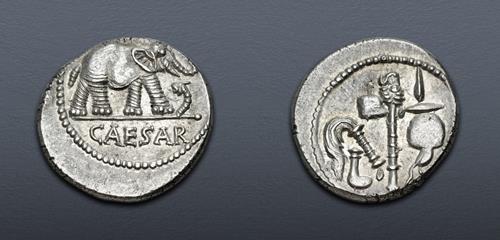|
The Caesarians. Julius Caesar. April-August 49 BC. AR Denarius (17mm, 3.90 g, 9h). Military mint traveling with Caesar. Elephant advancing right, trampling on horned serpent / Emblems of the pontificate: simpulum, aspergillum, securis, and apex. Crawford 443/1; CRI 9; Sydenham 1006; RSC 49; RBW 1557. Underlying luster, off center. EF.
Julius Caesar and his armies assembled on the banks of the Rubicon River on 10 January 49 BC, ready to invade Italy. Since large quantities of denarii were necessary to pay Caesar's military expenses, the mint traveled with them. This issue was ordered, not by a moneyer, as was usual, but by Julius Caesar himself. The obverse clearly depicts the triumph of good over evil, numismatic propaganda designed to encourage Caesar's soldiers during the long, intense campaign. The reverse, depicting priestly emblems, tells of Caesar's office as Pontifex Maximus, high priest. In all likelihood, this type was used by Caesar's military forces at least until the decisive battle of Pharsalus.
The final winners of all CNG Feature Auction 129 lots will be determined during the live online sale that will be held on 13-14 May 2025. This lot is in Session Two, which will begin 13 May at 2 PM ET.
Winning bids are subject to a 22.5% buyer's fee for bids placed on this website and 25% for all others.
We recognize that our users may have various Internet Browsers and Operating Systems. We like our visitors to have the best possible experience when using our bidding platform. However, we do recognize that it is impossible to develop applications that work identically, efficiently and effectively on all web browsers. The CNG bidding platform supports the latest stable major version and stable previous version of Chrome and Firefox.
|
